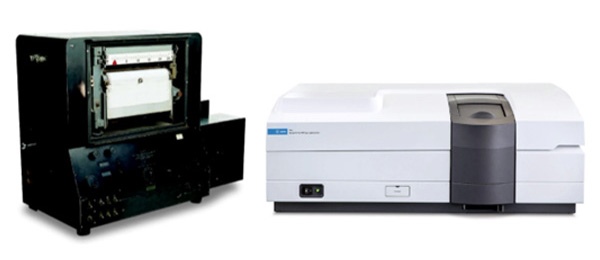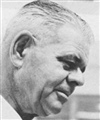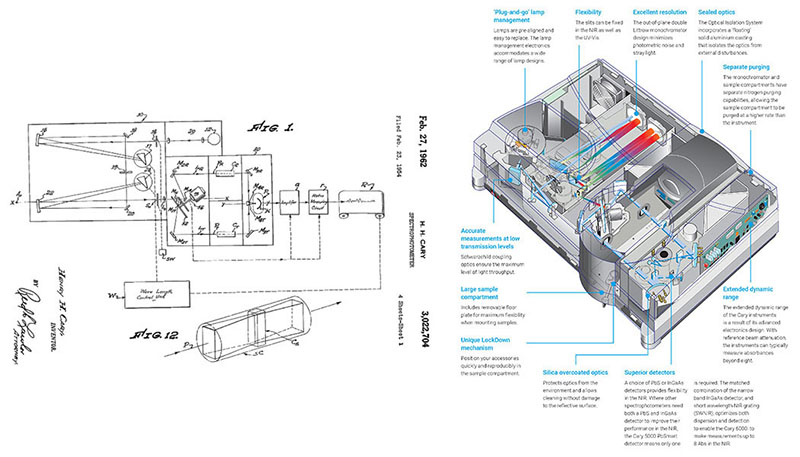
Howard H. Cary: an instrumental scientist ahead of his time
 It certainly sounds simple on paper: generate light, separate it into its constituents, send it to a sample. This is the most straightforward interpretation of molecular spectrophotometry, but also where a fascinating story begins. In the early days of analyzing matter using light (circa the 1940’s), two fundamentally different implementations of UV-Vis spectrophotometers were being developed—single beam and double beam systems. Howard H. Cary clearly favored the latter, noting superior performance of double beam monochromators over single beam varieties, and thus he branched off and designed his own take on the UV-Vis spectrophotometer with William W. Miller, George W. Downs, and Russel E. Vaniman.
It certainly sounds simple on paper: generate light, separate it into its constituents, send it to a sample. This is the most straightforward interpretation of molecular spectrophotometry, but also where a fascinating story begins. In the early days of analyzing matter using light (circa the 1940’s), two fundamentally different implementations of UV-Vis spectrophotometers were being developed—single beam and double beam systems. Howard H. Cary clearly favored the latter, noting superior performance of double beam monochromators over single beam varieties, and thus he branched off and designed his own take on the UV-Vis spectrophotometer with William W. Miller, George W. Downs, and Russel E. Vaniman.
Cary’s philosophy of performance with flexibility, along with careful treatment of light from source to detector, resulted in the first commercial recording UV-Vis spectrophotometer, the Cary 11 UV-Vis. First sold in 1947 to the Mellon Institute in Pittsburg, USA, this instrument provided unprecedented sensitivity and allowed scientists to gain new insights other instruments couldn’t discern at the time. Nobel chemistry laureate Bruce Merrifield once said it was "probably the most important instrument ever developed towards the advancement of bioscience."
75 years of Cary performance

Now many people would be forgiven for thinking Cary spectrophotometers have “incredibly bright light sources” or “very sensitive detectors”. While both of these are certainly credible to an extent, the real secret to Cary performance lies in the aforementioned careful treatment of all light within the instrument. Minimal use of transparent optics, large reflective surfaces, double beam design, and robust protection against light leakage are just some of the ideas that make the Cary name synonymous with performance. Even in modern Cary spectrophotometers, such as the Cary 3500 UV-Vis, Cary 5000 UV-Vis-NIR and Cary 7000 UMS UV-Vis-NIR, elements of Howard H. Cary’s original Cary 11 design are still present. It’s clear the benefit of the original Cary philosophy has withstood the test of time.
What can’t a Cary do?
“If a Cary can’t do it, then it can’t be done." These bold words are often spoken by individuals demonstrating the capabilities of Cary spectrophotometers. However, the best proof of Cary prowess is the sheer number and variety of industries which depend heavily on these instruments. These can easily span routine analyses in the pharmaceutical and nutraceutical industries, to more exotic areas like filter characterization for 3D cinema experiences, automotive, and space applications. Certainly not every problem needs the peerless power of a Cary spectrophotometer, however in analyses with no room for error, getting a Cary on the job is a trusted first step.
Celebrating 75 years of Cary success
This grand milestone wouldn’t be complete without a means of paying it forward to scientists breaking new ground with the help of the very latest Cary spectrophotometers. As such, Agilent is offering eligible customers 75% off a 2-year Enhanced Extended Warranty service contract on purchases of high-end Cary spectrophotometers (Cary 4000 / 5000 / 6000i / 7000 UMS). Read our Cary 75th anniversary announcement, or contact your local Agilent sales representative for further details.

Further reading
- Infographic: When Optics Matter, Your Choice Is Clear (History of Cary Spectrophotometers)
- Technical overview: Advance Your Materials with Cary 7000 UMS
- Technical overview: Agilent Cary 4000/5000/6000i Series UV-VIS-NIR Spectrophotometers
- Application note: A Faster, More Accurate Way of Characterizing Cube Beamsplitters
- Application note: Gaining Deeper Insights into Thin Film Response
- Application note: Measuring the Optical Properties of Photovoltaic Cells
Molecular spectroscopy webinar series
Get the latest product information and lots of helpful tips and tricks from our frequent molecular spectroscopy webinars. These live and interactive sessions take place every week, with all previous sessions available to watch on-demand.
- Got a question? Leave a note on the comments below or send your query directly to our expert spectroscopy team.
